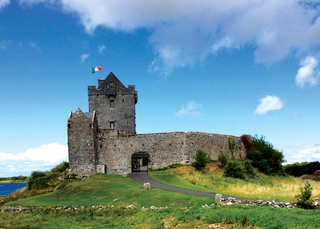
Aidhne, also known as Uí Fhiachrach Aidhni, Mag nAidni, later Maigh Aidhne, was the territory of the Uí Fhiachrach Aidhni, a túath located in the south of what is now County Galway in the south of Connacht, Ireland.. Aidhne is coextensive with the present diocese of Kilmacduagh.

Dunguaire Castle is a 16th-century tower house on the southeastern shore of Galway Bay in County Galway, Ireland, near Kinvara. The name derives from the dun (fort) of King Guaire, the legendary king of Connacht.
Aedh mac Ruaidrí Ua Conchobair was King of Connacht from 1228 to 1233. He was one of the sons of the last fully recognized High King of Ireland Ruaidrí Ua Conchobair, and claimed the kingship of Connacht after deposing his brother Toirdhealbhach Ó Conchobhair, after the death of their rival, cousin and former king Aedh Ua Conchobair. In 1233 he was killed in battle by the supporters of his cousin and successor Felim O'Connor. He was the last descendant of Ruaidrí to hold the kingship.

Felim O'Connor was king of Connacht in Ireland, having been proclaimed king by Richard Mór de Burgh in 1230, he reigned proper from 1233 until 1265. Felim died in that year and was buried in the Dominican Priory in Roscommon which he founded in 1253. On his accession Felim inherited many problems from his predecessors, having his territory limited to essentially County Roscommon and having to deal with an increase of English and Welsh settlers in the kingdom. Felim attempted to maintain both a loyal and personal relationship with Henry III King of England, hoping he would limit the influence of de Burgh and other powerful Anglo-Norman magnates in Connacht, but this policy of appeasement produced few concrete results. During Felim's reign the lands of the Ua Conchobair became limited to the five 'royal cantreds', essentially County Roscommon. Felim notably adopted aspects of Anglo-Norman culture as seen in his English style effigy and seal.
Áed mac Felidlimid Ó Conchobair, known as Áed na nGall, was king of Connacht alongside his father Felim from 1258 reigning solely from 1265 until his own death in 1274. He is credited with turning the tide on Norman expansion in Connacht at the Battle of Áth an Chip. Aed took a different approach than his father to dealing with English crown authority in Ireland, placing his faith in alliances with the Gaelic speaking world and becoming the chief supporter of Brian Ua Neill's bid to revive the high kingship of Ireland. His byname na nGall comes from his marriage in 1259 to a daughter of Dubhghall mac Ruaidri King of the Hebrides which brought him 160 gallowglass commanded by Dubhghall's younger brother Ailéan as a dowry.
MacFirbis, also known as Forbes, was the surname of a family of Irish hereditary historians based for much of their known history at Lecan, Tireragh. They claimed descent from Dathí (d.418?/428?), said to be one of the last pagan Kings of Connacht, and were thus one of the many families who sprang from the Uí Fiachrach dynasty. The progenitors of the MacFirbis family descend from Amhailgadh, whose brothers included Fiachra Ealg and Eocha Breac.
The Mac an Bháird family was one of the learned families of late medieval Ireland. The name has evolved over many centuries, the anglicised forms coming down as MacAward, McWard, MacEward, MacEvard, Macanward, M'Ward, and its most commonly used variant today: Ward. The name means 'son of the bard' and has no connection with the English name Ward, which originated from the Saxon word weard meaning watchman or guardian. Additionally, considerable numbers of Latin, French, and Spanish variants can be found in Continental records: Vardeo, Bardeo, U Bart, Wardeum, Vyardes, Wardeus, not to mention Verdaeorum familiae: the Ward family.

The Uí Briúin were a royal dynasty of Connacht. Their eponymous apical ancestor was Brión, son of Eochaid Mugmedon and Mongfind, and an elder half brother of Niall of the Nine Hostages. They formed part of the Connachta, along with the Uí Fiachrach and Uí Ailello, putative descendants of Eochaid Mugmedon's sons Fiachra and Ailill. The Uí Ailello were later replaced as the third of the Three Connachta, through genealogical sleight of hand, by the Uí Maine.
Events from the year 1337 in Ireland.
Maelsechlainn Ó Cellaigh, king of Uí Maine, Chief of the Name, died in 1402.
Maelsechlainn mac Tadhg Ó Cellaigh, King of Uí Maine, Chief of the Name, was a leading participant in the Battle of Knockdoe, fl. 1499–1511.
Gilla na Naemh Crom Ó Seachnasaigh was an Irish Chief of the Name.
Melaghlin Reagh Ua Seachnasaigh was an Irish Chief of the Name.
The Kings of Ui Fiachrach Muaidhe were the northern branch of Ui Fiachrach, based on the plain of the Muaidhe.
Conchobair Ó Dubhda was King of Ui Fiachrach Muaidhe.
Sén-Brian Ó Dubhda was King of Ui Fiachrach Muaidhe.
Caomhán mac Connmhach, Eponym and Ancestor of the Clan Ó Caomháin of north Connacht, fl. 9th-10th century. The surname is variously anglicised as Keevan, Kevane, Keeveen, Keevans, Keaven, Keavan, Cavan.
Coolcarney, also called Callraighe of Cuill, was an Irish district located in Connacht, within the Barony of Gallen stretching across both County Mayo, and County Sligo. It was unique in that it was a separate principality of the Uí Fiachrach from the rest of the Barony of Gallen.





